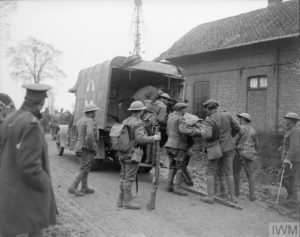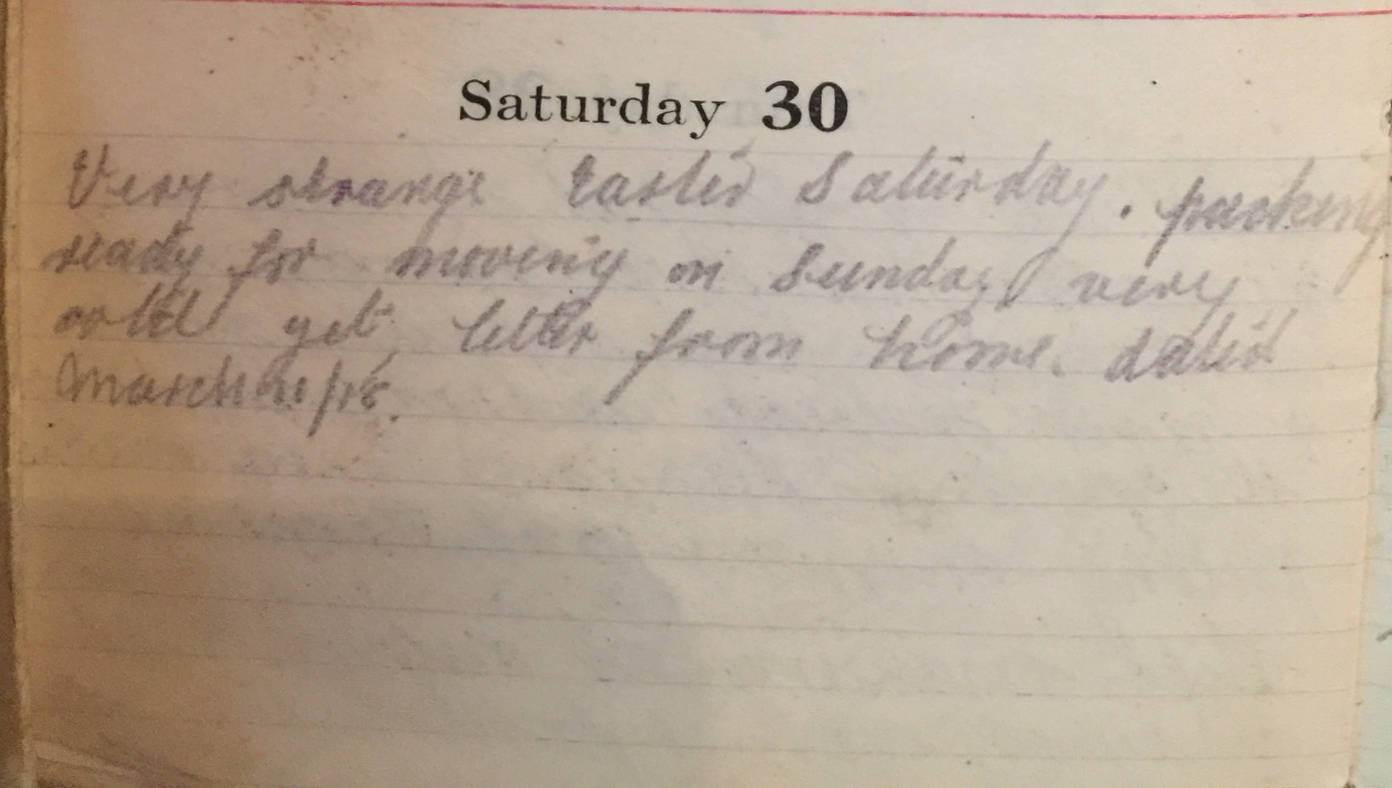Saturday March 30th, 1918
Very strange Easter Saturday. Packing, ready for moving on Sunday. Very cold. Got letter from home dated March 11, 1918.
Frank got a letter today dated March 11th, ten days before the Spring Offensive began. While news may be filtering through to official channels by now, it is clear that Frank is still ignorant of the events on the Western Front. Not so the people at home.
The Western Front
The Observer on Sunday will report that the war on the Western Front, stagnant for so long, is on the move again. ‘No longer reckoning progress as before by dull yards the fighting has travelled and swept over forty miles of landscape, over hill, river, and plain far away from our line as it stood in front of Cambrai, St Quentin, and La Fere, where the battle opened. The dead wilderness of the old Somme battlefields has awakened again to the thunder of the armies.’ In layman’s terms, this surge by the Germans means that the fighting has moved to within 60 miles of the Channel.
While clearly still reeling from the German attack and its success, the papers are already reporting, quite correctly, that the strategic ambitions of Ludendorff have not been achieved. Their analysis of the cause of the Allied reverses were also accurate. The Observer identified three: a) battle caught us in a transitional period (5th Army was in process of taking over a section of the French line and was under-resourced); b) our reserves were slow in arriving; and c) the coordination between the two armies was not as complete as should have been.²
To address the second of these, on 23rd March, Lloyd George, on his own authority, despatched all available troops to the Western Front and tripled the cross-Channel transports.³ Immediately too, debate started about raising the upper age of conscription from 45.
To address the lack of inter-army cooperation, on March 26th, General Foch was given responsibility for the coordination of the Allies on the Western Front. Over the coming fortnight this will be solidified and expanded. By April 14th he becomes ‘Commander in Chief of the Allied Armies in France’ with responsibility for all forces including the Americans. While obviously a difficult role in practice, he is given command of the all the reserves which he will use judiciously over the coming months.³
Consequences

The losses on both sides, when tallied, will be horrendous. Over the course of Operation Michael, the Allies will suffer 255,000 casualties and have over a thousand guns and 200 tanks seized. The Germans will loose 239,000 – a disproportionate percentage of them crack storm troopers.¹ Hundreds of thousands of men on both sides will also become casualties of the remaining three operations (Georgette, Blücher-Yorck and Gneisenau).
The photograph was taken during the Battle of Hazebrouck in April 1918. Wounded troops are being evacuated from a dressing station near Merris. The ambulance is of the British 34th Division.
Of the offensive, AJP Taylor summarized, ‘On 28 March [Ludendorff] expanded his offensive northwards towards Arras, and imagined that his armies would reach Amiens at a bound. At Arras there were strong British forces. No German advance was made. The Germans were pushing into a sack, the sides of which were thickening around them. They had acquired a dangerous bulge or salient instead of a breakthrough. On April 5th the offensive was halted.’ ³
Whilst the German’s Spring Offensive still has months to run, with setbacks for both sides, the dye is cast. The mobile war, now resumed, will go on to the Armistice with momentum shifting to the Allies. Foch as the orchestrater on the Western Front, increased American involvement, more British troops, and Germany’s losses will all play a role in the outcome.
13th (Service) Battalion War Diary – 30h March 1918 – No 1 Sector, Olasli
The Battalion bombers carried out a scheme with live grenades under the Bombing Officer. As the Battalion is not being relieved at the present camp, dismantling parties have been at work on the Officers’ Messes, Drying Rooms, and Roofs over the Latrines. Operation Order No 34 (Appendix 4) issued at 09:00 hrs. The Battalion will move on the 31st to Rates and will relieve the 7th South Wales Borderers at Saida on the 1-4-18 in Section Reserve.
References & Further Reading
¹ ‘Spring Offensive‘ in Wikipedia
² Article in ‘The Observer’ March 31st, 1918, page 4
³ ”The First World War: An Illustrated History’ by AJP Taylor (Penguin), Kindle Locn 2260
* Image (Q 8696) copyright of Imperial War Museums


